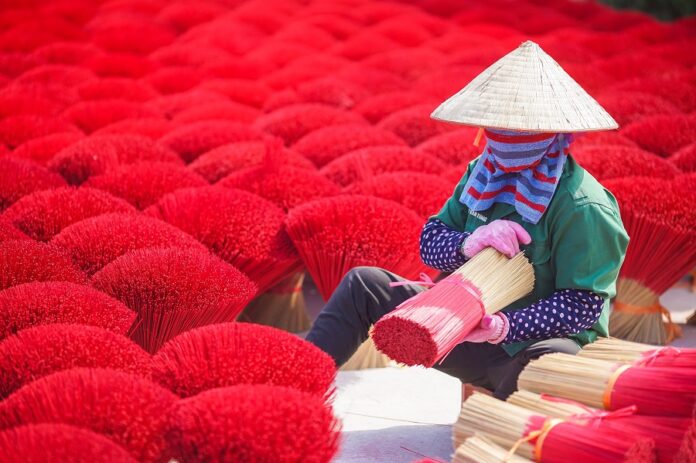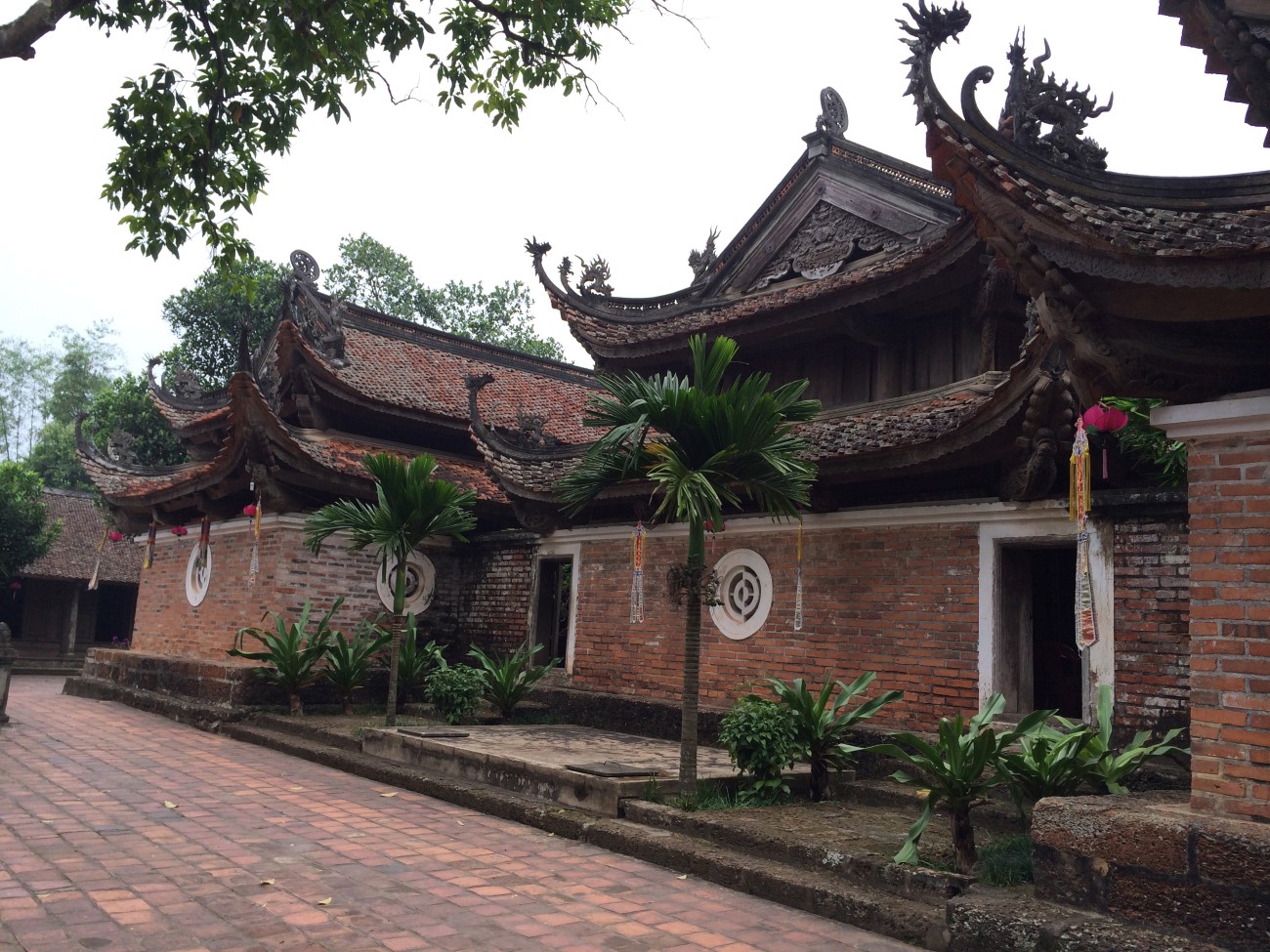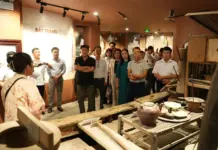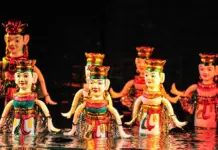Hanoi’s suburban expanse, a treasure trove of diverse landscapes, artisanal villages, and historical relics, presents a unique opportunity to craft captivating tours. These tours will not only enchant visitors but also catalyze socio-economic transformation within the region.
| The Quang Phu Cau Incense Village, nestled on Hanoi’s outskirts, captivates visitors with its singular scenery and vibrant energy. Photo: Huy Pham/The Hanoi Times |
Unveiling Untapped Potential
Hanoi’s suburbs encompass 17 districts and a town, each endowed with distinct advantages and untapped potential for tourism growth. Hoang Viet Cuong, from Gia Lam’s Culture and Information Unit, highlights the area’s rich historical and cultural tapestry, boasting 320 relics, including the nationally recognized Phu Dong Temple. The region also proudly preserves vibrant traditional festivals such as the Giong Festival and the Chu Dong Tu Festival.
Other districts within Hanoi proudly showcase their unique offerings, such as Son Tay Ancient Citadel, Va Temple, and Duong Lam Ancient Village in Son Tay Town. Thuong Tin District is home to the revered Nguyen Trai Shrine, while Thanh Oai District boasts the Cu Da and Uoc Le Ancient Villages. Notably, the My Duc District attracts millions of visitors annually to the iconic Huong Pagoda Complex.
It is worth noting that many of these priceless relics are conveniently located along the city’s main transportation arteries. For instance, the iconic Thang Long Avenue provides easy access to the special national relics of Thay Pagoda and Tay Phuong Pagoda, while National Road 32 leads travelers to the Dai Phung Communal House, Hat Mon Temple, and the ancient sites in Son Tay Town.
| The time-honored art of soy sauce making is kept alive at Duong Lam Ancient Village, Son Tay Town, Hanoi. Photo: Huy Pham/ The Hanoi Times |
Despite being touted as the “gold mine” of Hanoi’s tourism industry, the suburbs have not fully harnessed their potential, as evidenced by the relatively low visitor numbers. Tran Duc Hai, Secretary of the Dan Phuong District Party Committee, acknowledges the lack of signature products and seamless connections between the downtown core and the suburbs as significant hurdles to tourism growth in the area.
Do Manh Hung, Chairman of the Ba Vi District People’s Committee, shares a similar sentiment, attributing the underutilization of Ba Vi’s tourism potential to a lack of collaboration with travel agencies and challenges in transport infrastructure development. As a result, even locals find it difficult to access the district’s breathtaking destinations.
“A common challenge is the lack of clarity in identifying target customers, which leads to vague product planning and development strategies,” explains Tran Trung Hieu, Deputy Director of the Hanoi Tourism Department. He further adds that the current supply of tourist services falls short of actual demand, and marketing efforts often lack professionalism. These factors contribute to the ongoing disparity between the suburbs’ potential and the number of visitors they attract.
Catalyzing Change for Breakthroughs
| Crafting conical hats at Chuong Craft Village, a traditional art passed down through generations in Thanh Oai District, Hanoi. File photo |
To fully capitalize on the strengths of Hanoi’s suburbs and attract a larger tourist influx, experts emphasize the need for communities to enhance the quality of local tourism products, invest in cohesive infrastructure, foster a healthy tourism ecosystem, and forge stronger connections with businesses.
Emmanuel Cerise, director of the Paris Region International Cooperation Support Agency in Vietnam, highlights the keen interest of foreign visitors, especially those from European nations, in exploring the cultural heritage of Asian countries. He encourages Hanoi to prioritize heritage conservation alongside tourism development.
Nguyen Manh Than, Chairman of the Hanoi Tourism Association, advocates for tapping into the suburbs’ rich potential by creating new and distinctive tourism products while clearly defining target audiences. Nguyen Tien Dat, CEO of AZA Travel, echoes this sentiment, stressing the need to develop highly experiential and interactive tourism products, with an initial focus on handicraft village tourism and agrotourism. He emphasizes the importance of close collaboration with central city authorities to design cohesive tours and routes.
| The serene and iconic Tay Phuong Pagoda in Thach That District, Hanoi, attracts visitors seeking cultural immersion. Photo: Cocochine Saigon |
Nguyen Tuan Anh, Vice President of the Hanoi Unesco Travel Club, suggests leveraging social media platforms like Facebook and Zalo to enhance product promotion and reach a wider audience.
Looking ahead, Anh emphasizes the importance of implementing mechanisms and policies that encourage tourism businesses to invest in accommodation systems and meet the evolving demands of travelers.
Dang Huong Giang, Director of the Hanoi Tourism Department, acknowledges the crucial role of suburban tourism in the capital’s development plan. She underscores the need for localities to innovate new tourism products and foster strong connections, thereby transforming their potential into compelling attractions for visitors.
| The iconic Chua Huong (Perfume Pagoda) in My Duc District, Hanoi, is a spiritual and cultural destination for millions of visitors annually. Photo: Pham Hung/ The Hanoi Times |
Recently, the department, in collaboration with the suburban districts, introduced two new tourist routes themed “Discovering the South Thang Long Heritage Road.” These routes traverse central Hanoi and various districts, serving as models for future developments across all suburban areas.
In conclusion, unlocking the full potential of Hanoi’s suburban tourism requires a flexible and community-driven approach, coupled with effective promotion. By showcasing the region’s unique attributes and creating the necessary conditions for tourism growth, local authorities and residents can foster a vibrant and sustainable tourism industry.
The Grand Cultural Extravaganza: A Festival of Peace and Unity
Nearly ten thousand citizens and representatives from diverse city forces united as participants in the rehearsal for the grand opening of the “Cultural Festival for Peace.” This highly anticipated event will commence at 7 AM sharp on the 6th of October, with the rehearsal ensuring a seamless and spectacular start to the festival.
The Capital’s Time-Honored Charm: A Journey Back to Hanoi’s Subsidized Era
The exhibition, nestled in the heart of Hanoi, beckons travelers eager to delve into the city’s historical tapestry. It captivates those with a penchant for discovering the stories woven into Hanoi’s very fabric. Alongside, it also resonates with the youth, offering them a glimpse into the past that shapes their present.














